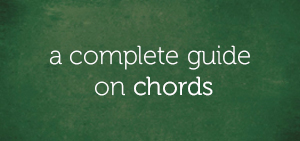Our focus in this lesson is on essential passing chords for beginners on the piano.
After learning primary chords (the 1-chord, 4-chord, and 5-chord) and how they are applied in accompaniment and harmonization, there is need to also explore passing chords because they add an extra dimension to chord progressions.
Attention: If you’re beyond the beginners skill level, then this lesson is NOT for you. You may check out this lesson on passing chords for intermediate players.
The goal of this lesson is to get you started with super basic passing chords that you can spice up chord progressions with at the moment.
Let’s take a look at the concept of passing chords before we proceed.
Passing Chords — Explained
A passing chord is [usually a chromatic] chord that connects two diatonic chords. For example, the movement in the key of C major:
…from the 1-chord:
…to the 5-chord:
…is known as the 1-5 chord progression.
The two diatonic chords in the 1-5 chord progression can be connected with a passing chord. The passing chord comes after the 1-chord and before the 5-chord.
The passing chord that connects the 1-chord and the 5-chord is the D major triad:
…which is a chromatic chord.
“So, Here’s The 1-5 Chord Progression Using The Passing Chord…”
The 1-chord:
…the passing chord:
…the 5-chord:
Although the 1-5 chord progression sounds pretty good, introducing a passing chord in-between to connect both chords adds more momentum to the chord progression.
“Oh Come All Ye Faithful [Regular Progression]…”
Oh come:
…all ye faith:
…ful.
“Oh Come All Ye Faithful [With Passing Chords]…”
Oh come:
…all:
…ye faith:
…ful.
You can see how the passing chord added more momentum to the chord progression.
Essential Passing Chords For Beginners
Let’s go ahead and explore passing chords to the scale tone chords you’re already familiar with:
The 1-chord
The 2-chord
The 3-chord
The 4-chord
The 5-chord
The 6-chord
All examples will be given using root position chords (triads) in the key of C major:
Feel free to invert and transpose the chords.
The Passing Chord To The 1-Chord
The 1-chord in the key of C major:
…is the C major triad:
…and its passing chord is the first inversion of the G major triad:
…with a B-note on the bass:
Altogether here’s the passing chord:
…to the 1-chord:
The Passing Chord To The 2-Chord
In the key of C major:
…the 2-chord is the D minor triad:
The passing chord to the 2-chord is the A major triad (played in first inversion):
…with a C#-note on the bass:
So, here’s the passing chord:
…to the 2-chord:
The Passing Chord To The 3-Chord
Still in the key of C major:
…the 3-chord is the E minor triad:
The passing chord to the 3-chord is the B major triad (played in first inversion):
…with a D#-note on the bass:
Altogether here’s the passing chord:
…to the 3-chord:
The Passing Chord To The 4-Chord
The 4-chord in the key of C major:
…is the F major triad:
…and its passing chord is the first inversion of the C major triad:
…with an E-note on the bass:
Altogether here’s the passing chord:
…to the 4-chord:
The Passing Chord To The 5-Chord
In the key of C major:
…the 5-chord is the G major triad:
The passing chord to the 5-chord is the D major triad (played in first inversion):
…with an F#-note on the bass:
So, here’s the passing chord:
…to the 5-chord:
The Passing Chord To The 6-Chord
The 6-chord in the key of C major:
…is the A minor triad:
…and its passing chord is the first inversion of the E major triad:
…with a G#-note on the bass:
Altogether here’s the passing chord:
…to the 6-chord:
“Why Is There No Passing Chord To The 7-Chord?”
Final Words
Congratulations! You just made it through to the end off this lesson and you’ve learned 6 passing chords that you can progress to different scale tone chords with.
Like I recommended earlier, after learning these chords, feel free to invert and transpose them to other keys.
See you in the next lesson.
Chuku Onyemachi
Latest posts by Chuku Onyemachi (see all)
- The Formation Of Diminished Seventh Chords Used To Be Challenging Until I Did This
- How To Form Seventh Chords In Two Shakes Of A Dog’s Tail Using Third Intervals And The Circle Of Fifths Chart
- I Played The 13sus4 Chord And This Happened…
- How To Build Seventh Chords Like An Architect Using “Foundation And Structure” Concept
- This 4-Week Plan Will Help You Master All The Major Scales







Comments on this entry are closed.